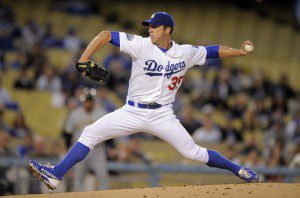
I was talking with my buddy about the Zack Greinke fiasco against the San Diego Padres. I was explaining to my pal (who doesn’t have a dog in the fight because he’s a New York Yankees fan) about what a punk Carlos Quentin was to charge Greinke after getting plunked in a 2-1 game.
My buddy said, “Well, if a pitcher had hit me two other times and then told me to shut the bad word up and take my base, I would have a big problem with that, too.”
Okay, so after looking at the situation from an objective point of view, I have come to the following conclusion: It doesn’t matter whether Quentin is/was a punk, and it doesn’t matter whether Greinke was dumb for not backing away from the altercation to protect his $147 million future.
What matters is this: The Dodgers must now scramble to fill out a revised starting rotation.
The Dodgers definitely have some pitching options during the eight weeks they will be without Greinke. What was once a surplus of starting pitchers to start the season has now become a survival of the fittest in Los Angeles.
Rumor has it the Dodgers decided to replace Greinke with lefty Chris Capuano. Capuano was pitching out of the bullpen this season, but started for the Dodgers last season.
Lefty Ted Lilly has been injured this season and is in the process of making his way back to the Dodgers while on a minor league rehab assignment. Once Lilly is healthy, the Dodgers will have some decisions to make in the starting rotation.
Here are some of the options in the Dodgers’ impending game of Starting Pitching Russian Roulette:
• The Case for Capuano – Capuano is healthy and has been since he signed with the Dodgers in 2012 as a free agent. The lefty won 12 games for the Dodgers last season and finished with a respectable 3.72 ERA. Capuano is also a cagey veteran (34 years old) and he won’t be rattled by having to step into a rotation that features Clayton Kershaw, Hyun-Jin Ryu, Josh Beckett and Chad Billingsley. After tossing almost 200 innings for the Dodgers in 2012, Capuano proved his durability.
• The Case Against Capuano – After starting the 2012 season like gangbusters and making the All-Star game, Capuano struggled over the second half. Capuano went 9-4 with a 2.91 ERA before the All-Star break, then fell apart and went 3-8 with a 4.76 ERA.
• The Case for Lilly – Make no mistake about it, the 37-year-old Lilly will never get a speeding ticket on the mound. Even in his prime (in which he is not), Lilly was a control pitcher who mixed speeds to keep hitters off-balance. Lilly might only be able to hit 90 on the radar gun with a nice Chavez Ravine tailwind, but he knows how to pitch. You don’t last 15 years in the majors and win 130 games unless you have talent. Lilly will grind away and get you five or six innings most every start. He won’t walk guys and he won’t strike them out. Lilly also hasn’t pitched in relief since 2002, so he’s basically a starter or bust.
• The Case Against Lilly – During his minor league rehab, Lilly has been lit up like a Christmas tree, allowing 10 runs and 17 hits in 12 innings. Lilly has also surrendered four homers over those 12 innings … to minor leaguers! Even though he has a way cool name (Theodore Roosevelt Lilly!), he has a career ERA of 4.13. Lilly has also given up an average of 31 homers a season since 2003, so it’s a good bet that he is going to get hit hard from time-to-time.
• The Case for Stephen Fife – Fife was called up from the minors to start five games for the Dodgers in 2012. While he posted an 0-2 record in those games, Fife struck out 20 hitters in 26 innings and had a 2.70 ERA. At triple-A last season, Fife went 11-7. In 2011 with the Red Sox and Dodgers (he came over in the Trayvon Robinson trade), Fife went 14-4 at double-A.
• The Case Against Fife – Fife is unproven at the major-league level, and you don’t know how he will hold up mentally on a team of stars. Although it was in the thin air of triple-A Albuquerque, Fife posted a fat 4.66 ERA last season.
